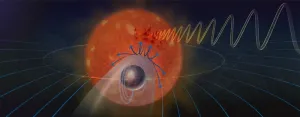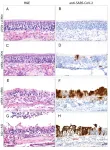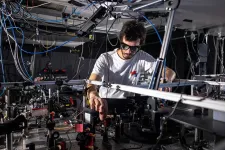(Press-News.org) Earth's magnetic field does more than keep everyone's compass needles pointed in the same direction. It also helps preserve Earth’s sliver of life-sustaining atmosphere by deflecting high energy particles and plasma regularly blasted out of the sun. Researchers have now identified a prospective Earth-sized planet in another solar system as a prime candidate for also having a magnetic field — YZ Ceti b, a rocky planet orbiting a star about 12 light-years away from Earth.
Researchers Sebastian Pineda and Jackie Villadsen observed a repeating radio signal emanating from the star YZ Ceti using the Karl G. Jansky Very Large Array, a radio telescope operated by the U.S. National Science Foundation’s National Radio Astronomy Observatory. Research by Pineda and Villadsen to understand the magnetic field interactions between distant stars and their orbiting planets is supported by NSF. Their research was published today in the journal Nature Astronomy.
"The search for potentially habitable or life-bearing worlds in other solar systems depends in part on being able to determine if rocky, Earth-like exoplanets actually have magnetic fields," says NSF's Joe Pesce, program director for the National Radio Astronomy Observatory. "This research shows not only that this particular rocky exoplanet likely has a magnetic field but provides a promising method to find more."
A planet's magnetic field can prevent that planet's atmosphere from being worn away over time by particles spewed from its star, explains Pineda, an astrophysicist at the University of Colorado. "Whether a planet survives with an atmosphere or not can depend on whether the planet has a strong magnetic field or not."
A radio signal from another star
"I'm seeing this thing that no one has seen happen before," recalls Villadsen, an astronomer at Bucknell University, of the moment she first isolated the radio signal while pouring over data at her home on a weekend.
"We saw the initial burst and it looked beautiful," says Pineda. "When we saw it again, it was very indicative that, OK, maybe we really have something here."
The researchers theorize that the stellar radio waves they detected are generated by the interactions between the magnetic field of the exoplanet and the star it orbits. However, for such radio waves to be detectable over long distances, they must be very strong. While magnetic fields have previously been detected on massive Jupiter-size exoplanets, doing so for a comparatively tiny Earth-sized exoplanet requires a different technique.
Because magnetic fields are invisible, it's challenging to determine if a distant planet actually has one, explains Villadsen. "What we're doing is looking for a way to see them," she says. "We're looking for planets that are really close to their stars and are a similar size to Earth. These planets are way too close to their stars to be somewhere you could live, but because they are so close the planet is kind of plowing through a bunch of stuff coming off the star.
"If the planet has a magnetic field and it plows through enough star stuff, it will cause the star to emit bright radio waves."
The small red dwarf star YZ Ceti and its known exoplanet, YZ Ceti b, provided an ideal pair because the exoplanet is so close to the star that it completes a full orbit in only two days. (By comparison, the shortest planetary orbit in our solar system is Mercury's at 88 days.) As plasma from YZ Ceti careens off the planet's magnetic "plow," it then interacts with the magnetic field of the star itself, which generates radio waves strong enough to be observed on Earth.
The strength of those radio waves can then be measured, allowing researchers to determine how strong the magnetic field of the planet might be.
Northern lights on another world?
"This is telling us new information about the environment around stars," says Pineda. "This idea is what we're calling 'extrasolar space weather.'"
The sun's high energy particles and sometimes huge bursts of plasma create solar weather closer to home, around Earth. Those ejections from the sun can disrupt global telecommunications and short-circuit electronics in satellites and even on Earth's surface. The interaction between solar weather and Earth's magnetic field and atmosphere also creates the phenomenon of the aurora borealis, or northern lights.
The interactions between YZ Ceti b and its star also produce an aurora, but with a significant difference: The aurora is on the star itself.
"We're actually seeing the aurora on the star — that's what this radio emission is," explains Pineda. "There should also be aurora on the planet if it has its own atmosphere."
Both researchers agree that while YZ Ceti b is the best candidate yet for a rocky exoplanet with a magnetic field, it's not a closed case. "This could really plausibly be it," says Villadsen. "But I think it's going to be a lot of follow-up work before a really strong confirmation of radio waves caused by a planet comes out."
"There are a lot of new radio facilities coming online and planned for the future," says Pineda of the possibilities for future research. "Once we show that this is really happening, we'll be able to do it more systematically. We're at the beginning of it."
END
Do Earth-like exoplanets have magnetic fields? Far-off radio signal is promising sign
Radio emissions originating about 12 light-years outside our solar system reveal possible magnetic interactions between star YZ Ceti and its prospective close-orbiting, rocky planet.
2023-04-03
ELSE PRESS RELEASES FROM THIS DATE:
Higher lithium levels in drinking water may raise autism risk
2023-04-03
Pregnant women whose household tap water had higher levels of lithium had a moderately higher risk of their offspring being diagnosed with autism spectrum disorder, according to a new study led by a UCLA Health researcher.
The study, published April 3 in JAMA Pediatrics, is believed to be the first to identify naturally occurring lithium in drinking water as a possible environmental risk factor for autism.
“Any drinking water contaminants that may affect the developing human brain deserve intense scrutiny,” said lead study author Beate Ritz, MD, PhD, professor of neurology in the David Geffen School of Medicine at UCLA ...
Nasal vaccine to prevent COVID-19 passes first tests
2023-04-03
Since the beginning of the COVID-19 pandemic, researchers have been working on mucosal vaccines that can be administered through the nose. Now, scientists in Berlin have developed a live attenuated vaccine for the nose. In “Nature Microbiology”, they describe the special immune protection it induces.
Joint press release by Freie Universität Berlin, Max Delbrück Center and Charité – Universitätsmedizin Berlin
Coronaviruses spread primarily through the air. When infected people speak, cough, sneeze or laugh, they expel droplets of saliva containing the virus. Other people then breathe ...
Research finds global emissions of several banned ozone-destroying chemicals are increasing
2023-04-03
The research, published today in Nature Geoscience and led by the University of Bristol and National Oceanic and Atmospheric Administration (NOAA), puts the rise in part down to the chemicals, known as chlorofluorocarbons or CFCs, being used to make other ozone-friendly alternatives to CFCs. This is an exception allowed under the Montreal Protocol, but contrary to its wider goals.
Lead author Dr Luke Western, a Research Fellow at the University of Bristol and researcher at the NOAA’s Global Monitoring Laboratory (GML), said: “We’re paying attention to these emissions now because of the success of the Montreal Protocol. CFC ...
Early menopause, later start to hormone therapy may increase risk of Alzheimer’s disease
2023-04-03
BOSTON — Women are more likely than men to develop Alzheimer’s disease (AD), with women making up two-thirds of the population living with AD. A new study, led by Mass General Brigham researchers, sheds light on the relationship between the risk of Alzheimer’s disease and age of menopause and use of hormone therapy (HT). The results, published in JAMA Neurology, indicate that early age at menopause may be a risk factor for AD dementia, but that women who were prescribed HT around the age of menopause onset did not show increased risk.
“HT is the most reliable way to ameliorate severe menopause symptoms, ...
Comparison of postpartum opioid prescriptions before vs during pandemic
2023-04-03
About The Study: In this study of 460,000 privately insured postpartum women, patients who gave birth to a single, live newborn after March 2020 were more likely to fill more potent and more frequent opioid prescriptions than patients who gave birth prior to March 2020. Increases were larger for patients delivering via cesarean birth than those delivering vaginally. Increases in opioid prescriptions may be associated with increased risk of opioid misuse, opioid use disorder, and opioid-related overdose among postpartum women.
Authors: Shelby R. Steuart, M.P.A., of ...
Genetics of preterm birth and pregnancy length clarified
2023-04-03
New knowledge of the genetic factors behind premature delivery and gestational duration has now emerged. Findings presented by a major international study under the aegis of the University of Gothenburg include the ways in which, before birth, the woman’s and the unborn child’s genes have mutually antagonistic effects.
These results, now published in the journal Nature Genetics, enhance the potential for long-term development of drugs to induce parturition (birth) and — even more importantly — achieve the goal of preventing preterm births.
Globally, preterm (or premature) birth is the most frequent immediate cause of death among newborns and children ...
More U.S. prostate cancer patients choosing active surveillance
2023-04-03
The number of prostate cancer patients in the U.S. choosing active surveillance over surgery or radiation has rapidly increased since 2010, rising from 16% to 60% for low-risk patients and from 8% to 22% for patients with favorable intermediate-risk cancers, according to a study published today in JAMA Internal Medicine.
Active surveillance includes actively monitoring prostate cancer for progression, with the intention to intervene with surgery or radiation therapy if the cancer progresses.
It is the preferred treatment option for men with low-risk ...
Double-slit experiment that proved the wave nature of light explored in time
2023-04-03
Imperial physicists have recreated the famous double-slit experiment, which showed light behaving as particles and a wave, in time rather than space.
The experiment relies on materials that can change their optical properties in fractions of a second, which could be used in new technologies or to explore fundamental questions in physics.
The original double-slit experiment, performed in 1801 by Thomas Young at the Royal Institution, showed that light acts as a wave. Further experiments, however, showed that light actually ...
Researchers show lorlatinib is safe and effective for patients with ALK-driven relapsed/refractory high-risk neuroblastoma
2023-04-03
Philadelphia, April 3, 2023—In a significant step for the treatment of neuroblastoma, an international group of researchers led by Children’s Hospital of Philadelphia (CHOP), Winship Cancer Institute of Emory University and the New Approaches to Neuroblastoma Therapy (NANT) Consortium has shown that the targeted therapy lorlatinib is safe and effective in treating high-risk neuroblastoma. The findings, published today in Nature Medicine, have led to a major amendment in a phase 3 Children’s Oncology Group (COG) clinical trial, which has incorporated lorlatinib for newly diagnosed ALK-driven high-risk neuroblastoma, ...
Hidden ice melt in Himalaya: Study
2023-04-03
A new study reveals that the mass loss of lake-terminating glaciers in the greater Himalaya has been significantly underestimated, due to the inability of satellites to see glacier changes occurring underwater, with critical implications for the region's future projections of glacier disappearance and water resources.
Published in Nature Geoscience on April 3, the study was conducted by an international team including researchers from the Chinese Academy of Sciences (CAS), Graz University of Technology (Austria), the University of St. Andrews (UK), and Carnegie Mellon ...
LAST 30 PRESS RELEASES:
Manta rays create mobile ecosystems, study finds
Study: Mixed results in using lipoic acid to treat progressive multiple sclerosis
Norbert Holtkamp appointed director of Fermi National Accelerator Laboratory
New agentic AI platform accelerates advanced optics design
Biologists discover neurons use physical signals — not electricity — to stabilize communication
Researchers discover that a hormone can access the brain by hitchhiking
University of Oklahoma researcher awarded funding to pursue AI-powered material design
Exploring how the visual system recovers following injury
Support for parents with infants at pediatric check-ups leads to better reading and math skills in elementary school
Kids’ behavioral health is a growing share of family health costs
Day & night: Cancer disrupts the brain’s natural rhythm
COVID-19 vaccination significantly reduces risk to pregnant women and baby
The role of vaccination in maternal and perinatal outcomes associated with COVID-19 in pregnancy
Mayo Clinic smartwatch system helps parents shorten and defuse children's severe tantrums early
Behavioral health spending spikes to 40% of all children’s health expenditures, nearly doubling in a decade
Digital cognitive behavioral treatment for generalized anxiety disorder
Expenditures for pediatric behavioral health care over time and estimated family financial burden
Air conditioning in nursing homes and mortality during extreme heat
The Alps to lose a record number of glaciers in the next decade
What makes a good proton conductor?
New science reporting guide published for journalists in Bulgaria
New international study reveals major survival gaps among children with cancer
New science reporting guide published for journalists in Turkey
Scientists develop a smarter mRNA therapy that knows which cells to target
Neuroanatomy-informed brain–machine hybrid intelligence for robust acoustic target detection
Eight SwRI hydrogen projects funded by ENERGYWERX
The Lundquist Institute and its start-up company Vitalex Biosciences Announces Strategic Advancement of Second-Generation fungal Vaccine VXV-01 through Phase 1 Trials under $40 Million Competitive Con
Fine particles in pollution are associated with early signs of autoimmune disease
Review article | Towards a Global Ground-Based Earth Observatory (GGBEO): Leveraging existing systems and networks
Penn and UMich create world’s smallest programmable, autonomous robots
[Press-News.org] Do Earth-like exoplanets have magnetic fields? Far-off radio signal is promising signRadio emissions originating about 12 light-years outside our solar system reveal possible magnetic interactions between star YZ Ceti and its prospective close-orbiting, rocky planet.






